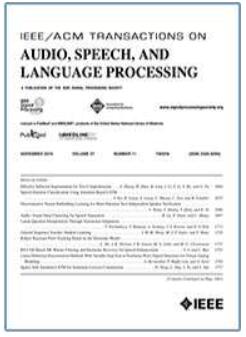E$^{3}$TTS: End-to-End Text-Based Speech Editing TTS System and Its Applications
IF 5.1
2区 计算机科学
Q1 ACOUSTICS
IEEE/ACM Transactions on Audio, Speech, and Language Processing
Pub Date : 2024-10-23
DOI:10.1109/TASLP.2024.3485466
引用次数: 0
Abstract
Text-based speech editing aims at manipulating part of real audio by modifying the corresponding transcribed text, without being discernible by human auditory system. With the enhanced capability of neural Text-to-speech (TTS), researchers try to tackle speech editing problems with TTS methods. In this paper, we propose EE$^{3}$TTS:端到端基于文本的语音编辑 TTS 系统及其应用
基于文本的语音编辑旨在通过修改相应的转录文本,在人类听觉系统无法识别的情况下,对部分真实音频进行处理。随着神经文本到语音(TTS)功能的增强,研究人员尝试用 TTS 方法来解决语音编辑问题。本文提出了 E$^{3}$TTS,即端到端基于文本的语音编辑 TTS 系统,它结合了文本编码器、语音编码器以及用于语音合成和语音编辑的联合网络。E$^{3}$TTS 可以通过处理给定文本,随意插入、替换和删除语音内容。实验表明,我们的语音编辑功能在 HiFiTTS 和 LibriTTS 数据集上的表现优于强大的基线,这两个数据集的说话者分别是见过或没见过的。此外,我们还将 E$^{3}$TTS 引入到自动语音识别(ASR)的数据增强中,以缓解代码转换和命名实体识别场景中的数据不足问题1。与过去的数据增强方法相比,E$^{3}$TTS 保留了录制音频的连贯性和真实性。实验结果表明,与传统的基于 TTS 的数据增强系统相比,E$^{3}$TTS 的性能有了显著提高。建议的语音编辑模型的代码和样本可在此资源库中获取2。
本文章由计算机程序翻译,如有差异,请以英文原文为准。
求助全文
约1分钟内获得全文
求助全文
来源期刊

IEEE/ACM Transactions on Audio, Speech, and Language Processing
ACOUSTICS-ENGINEERING, ELECTRICAL & ELECTRONIC
CiteScore
11.30
自引率
11.10%
发文量
217
期刊介绍:
The IEEE/ACM Transactions on Audio, Speech, and Language Processing covers audio, speech and language processing and the sciences that support them. In audio processing: transducers, room acoustics, active sound control, human audition, analysis/synthesis/coding of music, and consumer audio. In speech processing: areas such as speech analysis, synthesis, coding, speech and speaker recognition, speech production and perception, and speech enhancement. In language processing: speech and text analysis, understanding, generation, dialog management, translation, summarization, question answering and document indexing and retrieval, as well as general language modeling.
 求助内容:
求助内容: 应助结果提醒方式:
应助结果提醒方式:


